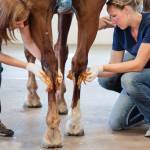Transcriptomics Markers to Clear Joint Infections in Horses

Successfully treating joint infections requires aggressive therapy and careful follow-up. But how do veterinarians know when the infection is cleared and treatment can be discontinued? A new study showed that messenger RNA (mRNA) may be a useful biomarker for identifying when infections have cleared.*
Treating joint infections often involves copious flushing of the joint along with aggressive antimicrobial therapy. Unnecessarily prolonging antimicrobial therapy, however, can result in side effects such as colitis (diarrhea) and antimicrobial resistance. Current techniques used for monitoring progression, and therefore resolution, of septic arthritis include synovial fluid analysis and bacterial culture. Those techniques may be unreliable in some cases, prompting veterinarians to seek alternate methods of identifying infection resolution.
“Transcriptomics is the study of RNA molecules, including mRNA, and how these transcripts relate to the function and structure of a cell, tissue, or organ. Identifying mRNAs that differ in expression levels between healthy and infected joints may help veterinarians determine when an infection has resolved and treatment may be discontinued,” explained Catherine Whitehouse, M.S., a Kentucky Equine Research nutrition advisor.
To establish if mRNA can be used to determine when joint sepsis has cleared, researchers experimentally induced (1) septic arthritis by injecting the bacterium Escherichia coli into one knee joint or (2) nonseptic synovitis in one knee joint. Five horses were included in each treatment group. Twenty-four hours after inducing arthritis or synovitis, all treated joints were lavaged and treated with antibiotics. Synovial fluid samples from the treated knees and the opposite healthy knees were collected at baseline prior to induction of infection or inflammation and again periodically between days 1 and 10 of treatment. Total nucleated cell counts of the synovial fluid and bacterial culture were performed on those days. In addition, total mRNA was measured on days 1 and 4.
“Eight mRNAs were identified as potential biomarkers that indicate eradication of infection using this model. Each of those mRNAs were upregulated (expressed at a higher level) in the synovial fluid of horses with septic arthritis on day 1 compared to horses after treatment and eradication of infection on day 4. Similarly, those mRNAs were expressed at higher levels in the infected joints prior to treatment compared to the joints with nonseptic synovitis on day 1,” explained Whitehouse.
mRNAs essentially create proteins from the DNA message. One of the proteins synthesized from one of the upregulated mRNAs in the septic joints was interleukin-1 receptor antagonist protein, the same protein produced in IRAP therapy for horses with osteoarthritis.
According to the research team, “Our results suggest that mRNA may be a useful source of biomarkers for the eradication of joint infection in horses and warrants further investigation.”
They also noted, however, that this study used experimentally induced infection and inflammation, not naturally occurring clinical cases. Further, the effects of the treatment (lavage and antibiotics) may also influence mRNA expression in synovial fluid, which was not evaluated.
Osteoarthritis, the painful and progressive degeneration of joints accompanied by inflammation, can develop as a complication following joint infection, even after successful treatment.
“Oral joint supplements help support joint health following septic arthritis or any sort of insult to a joint. Synovate HA is a high-molecular weight hyaluronic acid designed to support high-motion joints through its lubrication and cushioning properties,” Whitehouse said.
*Koziy, T.V., J.L. Bracamonte, G.S. Katselis, D. Udenze, S. Hayat, S.A. Hammond, and E. Simko. 2024. Putative mRNA biomarkers for the eradication of infection in an equine experimental model of septic arthritis. Veterinary Science 11(7):299.








